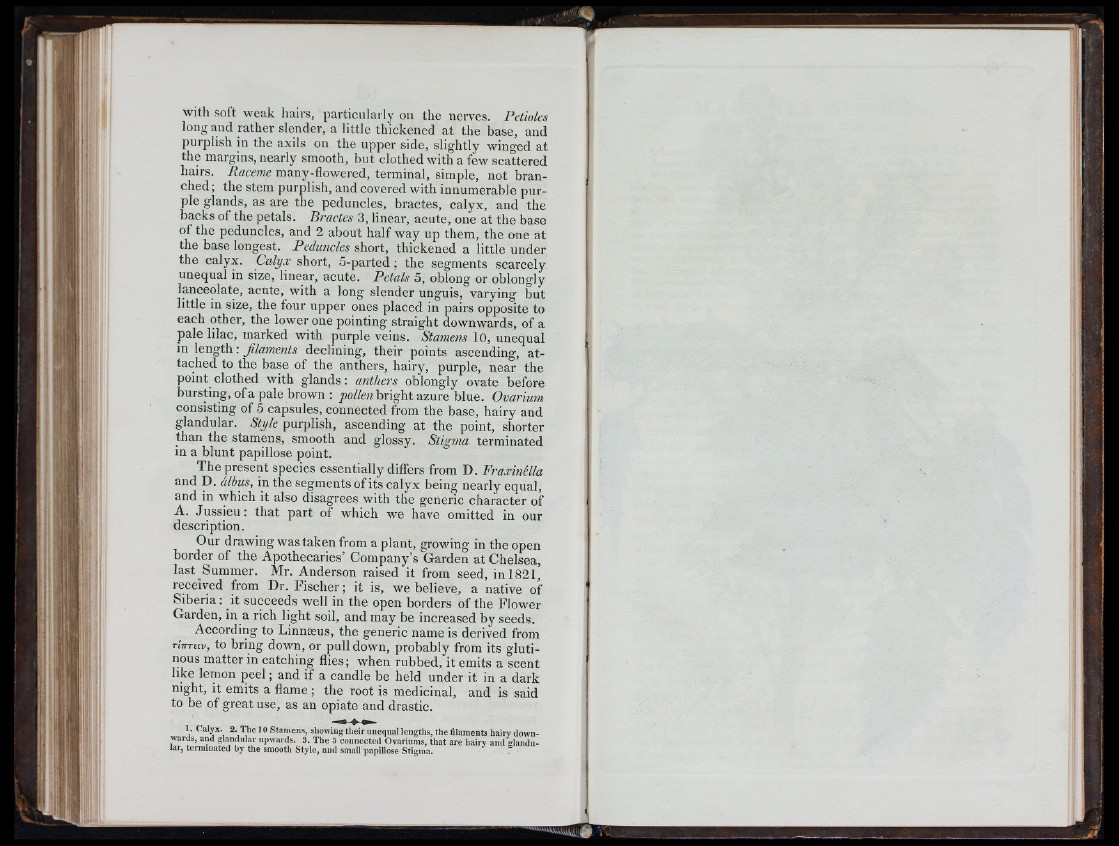
with soft weak Iiairs, particularly on the nerves. Petioles
long and rather slender, a little thickened at the base, and
purplish in the axils on the upper side, slightly winged at
the margins, nearly smooth, but clothed with a few scattered
hairs. Raceme many-flowered, terminal, simple, not branched
; the stem purplish, and covered vnth innumerable purple
glands, as are the peduncles, bractes, calyx, and the
backs of the petals. Bractes 3, linear, acute, one at the base
of the peduncles, and 2 about half way up them, the one at
the base longest. Peduncles short, thickened a little under
the calyx. Calyx short, 5-parted ; the segments scarcely
unequal in size, linear, acute. Petals 5, oblong or oblongly
lanceolate, acute, with a long slender unguis, varying but
little in size, the four upper ones placed in pairs opposite to
each other, the lower one pointing straight downwards, of a
pale lilac, marked with purple veins. Stamens 10, unequal
in length : Jilaments declining, their points ascending, attached
to the base of the anthers, hairy, purple, near the
point clothed with glands : anthers oblongly ovate before
bursting, of a pale brown : bright azure blue. Ovarium
consisting of 5 capsules, connected from the base, hairy and
glandular. Style purplish, ascending at the point, shorter
than the stamens, smooth and glossy. Stigjna terminated
in a blunt papillose point.
The present species essentially differs from D. Fraxinélla
and p . cUbus, in the segments of its calyx being nearly equal,
and in which it also disagrees with the generic character of
A. Jussieu: that part of which we have omitted in our
description.
Our drawing was taken from a plant, growing in the open
border of the Apothecaries’ Company’s Garden at Chelsea,
last Summer. Mr. Anderson raised it from seed, in 1821,’
received pom Dr. Fischer ; it is, we believe, a native of
Siberia : it succeeds well in the open borders of the Flower
Garden, in a rich light soil, and may be increased by seeds.
According to Linnæus, the generic name is derived from
tItttuv, to bring down, or pull down, probably from its glutinous
matter in catching flies ; when rubbed, it emits a scent
like lemon peel ; and if a candle be held under it in a dark
night, it emits a flame ; the root is medicinal, and is said
to be of great use, as an opiate and drastic.
1. Calyx. 2. The 10 Stamens, showing their unequal lengths, the filaments haiiw downwards,
and glandular upwards. 3. The 5 connected Ovariums, that are hairy and glandular,
terminated by the smooth Style, and small papillose Stigma.
a